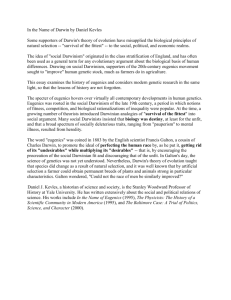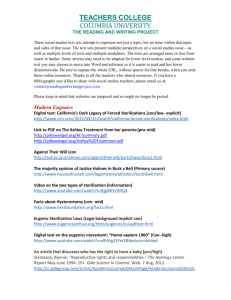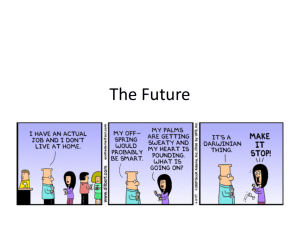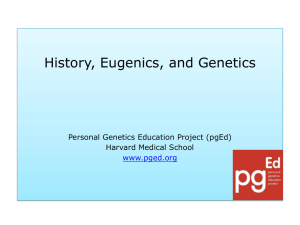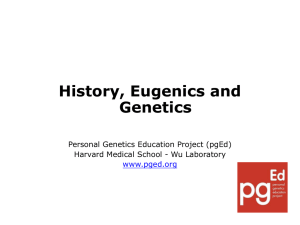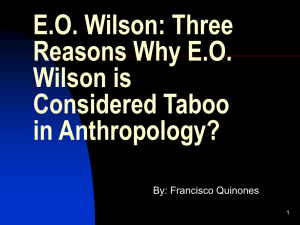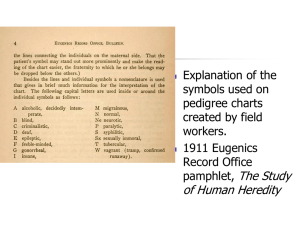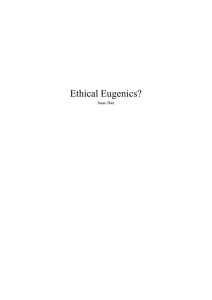Evolution and Eugenics” “ Lecture 15 Image courtesy of
advertisement
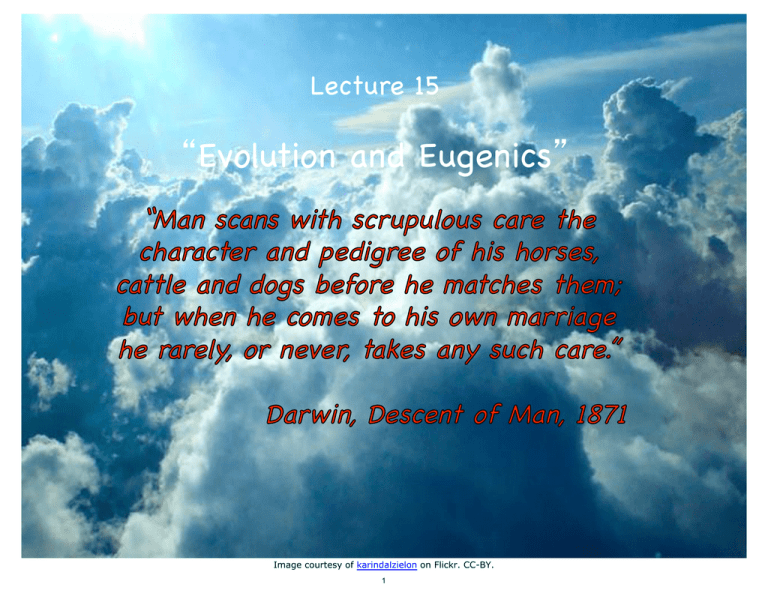
Lecture 15 “Evolution and Eugenics” Image courtesy of karindalzielon on Flickr. CC-BY. 1 Motto for today “No matter what anybody tells you, words and ideas can change the world.” Robin Williams, Dead Poets Society 2 Road Map Natural selection and human affairs A convert to evolution: Francis Galton Galton’s utopian vision: “eugenics” The eugenics movement in Britain The eugenics movement in the United States The long shadow of eugenics 3 Natural Selection and Human Affairs In the 1860s, many naturalists expressed doubts about natural selection as the main cause of evolution Many more (including Wallace) were skeptical that natural selection could account for human origins But at the same time, some who accepted Darwin’s theory worried that natural selection might not work on humans once they were civilized, with potentially disastrous consequences Today’s lecture is the (tragic) story of what became of this particular worry…. 4 Natural Selection and Civilization “In our complicated modern communities a race is being run between moral and mental enlightenment and the deterioration of the physical constitution through the defeasance of the law of natural selection;—and on the issues of that race the destinies of humanity depend.” �William R. Greg, "On the failure of 'Natural Selection' in the case of Man", Fraser's Magazine, 1868 5 “…a most intricate problem…”” �“The advancement of the welfare of mankind is a most intricate problem: all ought to refrain from marriage who cannot avoid abject poverty for their children; for poverty is not only a great evil, but tends to its own increase by leading to recklessness in marriage. On the other hand, as Mr Galton has remarked, if the prudent avoid marriage, whilst the reckless marry, the inferior members will tend to supplant the better members of society.” Darwin, Descent of Man, 1871 6 Francis Galton, 1822-1911 Darwin’s cousin Polymath – geographer, meteorologist, statistician, anthropologist, psychologist After reading the Origin, he devoted the next 50 years to investigating the effects of inheritance on human character In 1883, coined the term “eugenics” 7 Galton’’s tribute to Darwin “I always think of you in the same way as converts from barbarism think of the 0!$!.3$+9./0.!(%!2! them from the into[l]lerable burden of their superstition… the appearance of your ‘Origin of Species’ formed a real crisis in my life; your book drove away the constraint of my old superstition as if it had been *%#$0).!* 3/0$!9./0 to give me freedom of thought.” 8 9 Galton’’s vision “Hereditary Talent and Character””, 1865 Humans are evolved animals Mental as well as physical characteristics are overwhelmingly the result of inheritance The “0AC8N24” of civilization means that natural aptitude is not reliably favored by natural selection Therefore…“If a twentieth part of the cost and pains were spent in measures for the improvement of the human race that is spent on the improvement of the breed of horses and cattle, what a galaxy of genius might we not create!” 10 Galton’’s social hierarchy of genetic worth Criminals, undesirables Poor and low paid Low social and genetic desirability Respectable working class Skilled workmen, clerks, foremen, tradesmen Independent workers, large company owners High social and genetic desirability Eugenics "Eugenics is the study of the agencies under social control that seek to improve or impair the racial qualities of future generations either physically or mentally." Francis Galton, Inquiries into Human Faculty and its Development, 1883 12 12 “Positive”” and “negative”” eugenics Positive eugenics – Encouraging those of high eugenic worth to have children Negative eugenics – Discouraging/preventing those of low eugenic worth from having children 13 14 Galton’’5-1=7)1') Invented many techniques of statistical analysis Pioneered “nature/ nurture” studies (e.g., twin studies) Helped launch the mental testing (IQ) movement Co-invented forensic N=64A?A8=C8=6 Inspired the international eugenics movement 15 The eugenics movement in Britain Galton & his protégé Karl Pearson emphasized “positive 4D64=82B0=3E>;D=C0AH<40BDA4B4 6 N=0=280; incentives for eugenic marriages $0=H?A><8=4=C?D1;82N6DA4B1420<4BD??>AC4AB4 6 – Liberal economists William Beveridge, John Maynard Keynes – Fabian socialists George Bernard Shaw, H.G. Wells, Sidney Webb – Politicians Winston Churchill, Arthur Balfour Some “voluntary sterilizations” were performed on mentally ill patients, but no eugenic measures were ever passed into law 16 The eugenics movement in the U.S. 1894, The Immigration Restriction League adopted eugenic policies aimed at preserving the superior qualities of “American stock” 1896, Connecticut passed a eugenic marriage law – prohibited anyone who was "epileptic, imbecile or feebleminded from marrying 1906, The American Breeder’s Association was established under direction of biologist Charles B. Davenport – to “investigate and report on heredity in the human race, and emphasize the value of superior blood and the menace to society of inferior blood.” 1907, Indiana passed a compulsory sterilization law 17 Charles B Davenport, 1866-1944 Biologist, Director of Cold Spring Harbor Laboratory (1910) 40E8;H8=OD4=2431H Galton & Pearson Advocate of negative eugenics Founded Eugenics Record &5N24%4F/>A: =OD4=243?0BB064>5 eugenic sterilization immigration laws 18 Davenport’’s “eugenic creed”” (extracts) �"I believe that I am the trustee of the germ plasm that I carry; that this has been passed on to me through thousands of generations before me; and that I betray the trust if (that germ plasm being good) I so act as to jeopardize it, with its excellent possibilities, or, from motives of personal convenience, to unduly limit offspring.” �"I believe in such a selection of immigrants as shall not tend to adulterate our national germ plasm with /+%((51*900.%0/ 19 International Congresses of Eugenics 1st, London 1912 Organized by Eugenics Education Society, dedicated to Galton, with Major Leonard Darwin presiding; 400 attendees 2nd, New York, 1921 Held at American Museum of Natural History; State Dept mailed invitations round the world $09>A0AF8=03E>20C43C744;8<8=0C8>=>5C74D=NC the discouragement of large families in the "illendowed", and the encouragement of large families in the "well-endowed” 3rd, New York, 1932 20 New York, 1921 21 Good heredity for the sake of “health” 22 Henry H. Goddard, 1866-1957 American psychologist Director, Training School for Feeble-Minded Boys and Girls, Vineland, New Jersey Wrote, The Kallikak Family: A Study in the Heredity of Feeblemindedness, 1912 Leading advocate of use of IQ testing to identify feeble-minded 23 The “Kallikaks””: Goddard traced the family lineages of feeble-mindedness back across time 24 Mental testing on Ellis Island, 1913 � Use of “moron detectors” 80% of immigrants were found to be “feebleminded” The deportation rate increased 25 Use of IQ tests by US Ar my 1918 IQ tests US Army adopted their use with nonEnglish speaking or illiterate recruits “Complete the picture” 40% found were found to be “feebleminded” 26 A landmark case: Buck vs Bell 1924, Commonwealth of Virginia authorized compulsory sterilization of mentally retarded Virginia State Colony of Epileptics moved to have 18year-old Carrie Buck sterilized Buck’s guardian appealed to Circuit Court of Amherst County 1927, Supreme Court ruled 8:1 in favor of State of Virginia 27 Carrie Buck and her mother at the Virginia Colony for the Epileptic and Feebleminded 28 “Three generations of imbeciles are enough”” ”We have seen more than once that the public welfare may call upon the best citizens for their lives. It would be strange if it could not call upon those who already sap the strength of 0$!00!"+.0$!/!(!//!./.%9!/ often not felt to be such by those concerned, to prevent our being swamped with incompetence. It is better for all the world, if instead of waiting to execute degenerate offspring for crime, or to let them starve for their imbecility, society can ,.!2!*00$+/!3$+.!)*%"!/0(51*90 from continuing their kind.” Oliver Wendell Holmes, Supreme Court justice, Buck versus Bell, 1927 29 Photo courtesy of Political Graveyard on Flickr. CC-BY. The long shadow of eugenics Between 1907 & 1963, 64,000 individuals were compulsorily sterilized in the U.S. In the early 1930s, Buck vs. Bell was cited by the National Socialist Government in Germany as part of its argument for a coordinated mass sterilization program of mental defectives Eventually the Nazis went further, killing tens of thousands of the institutionalized disabled through compulsory euthanasia programs When Nazi administrators went on trial for war crimes 8=%DA4<14A605C4A.>A;3.0A C74H9DBC8N43C74 mass sterilizations (over 450,000 in less than a decade) by citing the United States as their inspiration. 30 The long shadow of eugenics Between 1907 & 1963, 64,000 individuals were compulsorily sterilized in the U.S. In the early 1930s, Buck vs. Bell was cited by the National Socialist Government in Germany as part of its argument for a coordinated mass sterilization program of mental defectives Eventually the Nazis went further, killing tens of thousands of the institutionalized disabled through compulsory euthanasia programs When Nazi administrators went on trial for war crimes 8=%DA4<14A605C4A.>A;3.0A C74H9DBC8N43C74 mass sterilizations (over 450,000 in less than a decade) by citing the United States as their inspiration. 31 Fitter Families contests and the Cross of Honor of the German Mother 32 “We do not stand alone”” Nazi propaganda poster, 1936 Woman holds baby, man holds shield inscribed with title of Germany’s 1933 compulsory sterilization law They’re surrounded by O06B>5=0C8>=BC70C703 enacted (or were considering) similar laws 33 “No matter what anybody tells you, words and ideas can change the world.” Robin Williams, Dead Poets Society 34 MIT OpenCourseWare http://ocw.mit.edu STS.009 Evolution and Society Spring 2012 For information about citing these materials or our Terms of Use, visit: http://ocw.mit.edu/terms.
